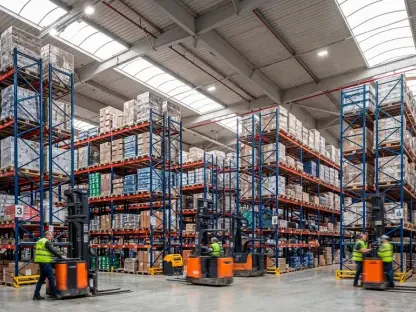Welcome to an insightful conversation with Rohit Laila, a veteran in the logistics industry with decades of experience spanning supply chain management and delivery systems. Rohit is also a fervent advocate for technology and innovation in the sector, making him the perfect person to discuss the evolving landscape of freight marketplaces. In this interview, we dive into the nuances of modern freight platforms, exploring how they differ from traditional load boards, their focus on specific shipper needs, the significance of strategic partnerships, and the unique processes that streamline logistics operations. We also touch on the financial models that support these platforms and their potential to reshape the industry.
How do you see modern freight marketplaces differing from traditional load boards in their approach to connecting shippers and carriers?
Modern freight marketplaces are a significant departure from traditional load boards because they prioritize structured, long-term relationships over one-off transactions. While load boards typically focus on spot loads—matching a truck with a load on short notice—marketplaces are more about creating a systematic environment for buying and selling transportation capacity. They cater to shippers looking for contractual or term-based arrangements, ensuring stability and predictability in moving large volumes of freight over time. Additionally, these platforms often integrate advanced tools to manage the entire process online, from negotiation to agreement, which is a big shift from the offline dealings common with load boards.
Why do you think the focus on medium and large shippers is so critical for these new freight platforms?
Medium and large shippers are often the backbone of freight marketplaces because they have consistent, high-volume needs that justify a platform built for strategic planning. These shippers require reliable capacity over extended periods, and they’re more likely to engage in regular procurement events like annual bids or monthly mini-bids. Unlike smaller shippers who might handle sporadic loads, larger ones benefit from a system that can organize complex logistics, connect them with approved carriers, and streamline their operations. It’s about matching their scale with a tool that can handle the depth of their requirements, which is why platforms often tailor features specifically for them.
Can you share your thoughts on the impact of a major shipper joining a freight marketplace as the first significant user?
When a major shipper joins a freight marketplace as the inaugural big player, it’s a game-changer. It validates the platform’s value proposition and draws attention from other shippers and carriers. For instance, having a well-known name commit to using the marketplace as their primary procurement tool signals trust and reliability. It also brings a network effect—hundreds of carriers often come along with that shipper, instantly boosting the platform’s ecosystem. This kind of partnership sets a precedent, showing others in the industry that the platform can handle significant logistics challenges and deliver results.
What’s the significance of tools like strategic RFQs and mini-bids in managing freight for shippers?
Strategic RFQs, or Requests for Quotations, are critical for shippers planning their transportation needs on a macro level, often run once or twice a year to secure capacity for major lanes or long-term contracts. Mini-bids, on the other hand, are smaller, more frequent events—think monthly or as-needed—used to fill gaps, like when a new customer lane opens up or a carrier relationship changes. These tools allow shippers to maintain flexibility while still securing capacity beyond just spot deals. They’re essential for balancing long-term planning with short-term adjustments, ensuring shippers aren’t caught off guard by sudden changes in demand or supply.
How does managing the entire deal process online within a marketplace benefit both shippers and carriers compared to traditional methods?
Managing everything online—from initial bid to final agreement—within a marketplace is a huge leap forward. Traditionally, negotiations often happened offline after parties connected on a load board, which could be time-consuming and prone to miscommunication. By keeping the process digital, there’s transparency and efficiency; everyone sees the same information in real-time, agreements are documented instantly, and there’s less room for error. For shippers, this means faster decision-making and better control over their logistics. For carriers, it provides clarity on terms and quicker access to confirmed loads, ultimately saving time and reducing operational friction.
What are your thoughts on the financial model where shippers use a freight platform for free while carriers pay a fee?
This financial model is quite strategic. By offering the platform at no cost to shippers, it lowers the barrier to entry, encouraging them to try the system without upfront investment. This can accelerate adoption, especially since shippers are the ones driving demand. Charging carriers a fee—often a modest monthly subscription—makes sense because they’re gaining access to a pool of consistent business from these shippers. It also incentivizes the platform to keep shippers happy with robust features, as their presence attracts carriers willing to pay. It’s a balanced approach that aligns the interests of both parties while ensuring the platform remains sustainable.
What is your forecast for the future of freight marketplaces in transforming the logistics industry?
I believe freight marketplaces are poised to fundamentally transform logistics by becoming the central hub for shipper-carrier interactions. As technology advances, I expect these platforms to integrate even deeper with transportation management systems, leveraging data analytics and automation to predict demand, optimize routes, and reduce inefficiencies. We’ll likely see more shippers, even smaller ones, adopting these tools as the platforms scale and offer tailored solutions. The focus on contractual arrangements over spot loads will drive stability in the market, and with growing networks of carriers and shippers, marketplaces could become the standard for how freight is procured and managed in the next decade.









